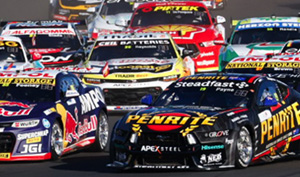PRODUCTION car racing was revitalised in Australia off the back of the early incarnations of the Bathurst 12 Hour.
After four previous Bathurst 12 Hour races at Easter from 1991 onwards, the event moved to Eastern Creek for 1995 where the highly competitive battle between Mazda and Porsche continued.
The inaugural Australian GT-Production Car Series played host to the shakedown of special homologation models set to battle at Eastern Creek. The rules at the time stated just 10 identical road-registerable examples of the model intended to be raced needed to be manufactured to be homologated.
Porsche’s new 911 RSCS raised the bar initially when released in early 1995, replacing the previous 968CS used by Peter Fitzgerald’s team since 1993.
Based on the 911, the RSCS was targeted at track day enthusiasts. All the creature comforts were removed including the carpets, power windows, air conditioning and radio, while a welded roll cage was included. Exterior wise, a larger spoiler was installed, and a deeper chin spoiler improved aerodynamic efficiency.

In response to the new model Porsche, Mazda’s team manager Allan Horsley developed the special RX7 SP special as the Japanese manufacturer aimed to continue its stranglehold on Australia’s premier production car event.
After taking a hattrick of Bathurst 12 Hour wins from 1992 to 1994, Mazda was forced to up the ante for 1995 and the SP was the result.
Over 120 parts were changed to create Mazda’s new performance benchmark including a lighter flywheel, larger diameter exhaust, carbon fibre air ducting and air box, modified turbo seals, plus a smaller, lighter battery. Also installed was a 110-litre fuel tank to combat one of Porsche’s advantages.
The body contained more carbon fibre and aluminium components including the bonnet, nose cone spoiler sourced from Mazdaspeed and a large rear wing, which is the model’s trademark.
The end result was Mazda’s fourth straight 12 Hour win as Dick Johnson and John Bowe claimed victory at Eastern Creek, beating home the 911 RSCS shared by Fitzgerald and Jim Richards.
At the time there were two other interesting production specials, one a bit obscure and one that didn’t even make the race at Eastern Creek.

Peter Brock’s association with Volvo started in 1994 when he partnered Tony Scott in an 850 T-5 in the Bathurst 12 Hour but the support ramped up for 1995.
Although not a homologation model like the three other cars mentioned in this article, the 850 T5-R was Volvo’s aim to kick its reserved image as it was doing in its British Touring Car Championship campaign.
Co-developed with Porsche, the T5-R achieved more power through a new ECU and an extra 1.5psi in boost. There were 6,964 T-5Rs produced though just 28 arrived in Australia, with a limited number featuring the five-speed manual transmission. Exterior modifications included a front spoiler with lip, rear wing and side skirts.
Two T5-Rs were entered for Eastern Creek and came up against a pair of Subaru Impreza WRXs in Class T for Turbo and/or four-wheel drive high performance cars.
Imprezas finished first and second in class with Brock and Tony Scott’s Volvo 16th overall and third in class (13 laps behind the class runner-up after striking issues) and the second car of Win Percy and Ed Ordynski too heavily delayed to complete enough laps to be classified as a finisher.
But at least the Volvos made it to Eastern Creek, which couldn’t be said for the BMW M3R.
At the time BMW was in a head-to-head battle with Audi for glory in Super Touring worldwide, including the growing Australian series where Frank Gardner led the two-car Diet-Coke line-up of Paul Morris and Geoff Brabham.
Gardner convinced BMW to allow his team to homologate 15 examples of its ultimate driving machine, the M3R. Unlike the stock M3, which competed at Bathurst’s 12 Hour in 1994, the R version featured revised camshafts, an upgraded intake, optimised exhaust ports, dual-pick up oil sump and a new ECU.

Just like the Mazda a lightened flywheel was featured and a choice of clutches depending on the M3R’s intended use. Brakes were also upgraded, a rear spoiler added, and 100 kilograms removed from the car’s overall weight.
Of the 15 imported, four were reportedly used on the track and 11 sold to the public, but the purchaser required a motor racing licence to buy one.
Although Morris debuted the M3R at the Oran Park Australian GT-Production Car Series round and it also ran in the rounds at Symmons Plains and Calder, it didn’t make an appearance at Eastern Creek and was consigned to Australian motorsport history.
This story also appears on the Repco Garage website.
For more news and content like this story, as well as videos competitions and podcasts, visit the Repco Garage here.




